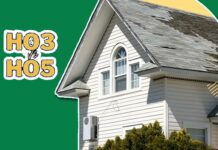Mine Subsidence Insurance- Beneath the ground in several parts of the United States, including states like Pennsylvania, Illinois, Ohio, Kentucky, and West Virginia, lie thousands of abandoned coal and mineral mines. While these underground mines may have been inactive for decades, they still pose a hidden risk to homeowners and property owners above them.

One of the most devastating issues that can occur is mine subsidence, when the ground suddenly sinks or shifts because of a collapsing mine beneath the surface. To protect against this unpredictable and costly danger, many homeowners turn to mine subsidence insurance.
What is Mine Subsidence?
Mine subsidence occurs when underground mining tunnels or voids collapse, causing the ground above them to sink or shift. This movement can result in significant structural damage to homes, driveways, roads, and even underground utilities. The damage may appear as cracks in walls or foundations, uneven floors, tilting chimneys, or sinking yards.
Unlike natural settling or minor ground movement, mine subsidence happens when the structural integrity of a mined-out area fails, leading to a sudden and sometimes dramatic drop in the land’s surface. Unfortunately, standard homeowners insurance policies typically exclude coverage for mine subsidence, leaving many property owners vulnerable to expensive repairs if they don’t have a separate policy.
What is Mine Subsidence Insurance?
Mine subsidence insurance is a special type of property insurance designed to protect homeowners and business owners from damage caused by the collapse or shifting of abandoned underground mines. It covers the cost of repairing or rebuilding structures affected by such ground movement.
This insurance acts as a safety net for people who live in or near former mining regions where the risk of subsidence remains a possibility. It’s particularly important in states where mining was historically common, as many of these old mines were poorly mapped and their exact locations may be unknown.
What Does Mine Subsidence Insurance Cover?
The coverage provided by mine subsidence insurance typically includes:
- Structural Damage to Buildings: It pays for repairs to your home, garage, or other insured structures that suffer physical damage as a direct result of ground movement caused by a collapsing mine.
- Foundation and Wall Cracks: Coverage often includes cracks in walls, floors, and foundations that are directly linked to mine subsidence activity.
- Reconstruction Costs: If the damage is extensive and your home becomes unsafe or uninhabitable, the policy may cover the cost of rebuilding or replacing the structure.
However, the policy does not usually cover:
- Damage caused by normal ground settling or soil erosion
- Damage to driveways, patios, fences, or other non-structural outdoor items
- Damage caused by earthquakes, floods, or other natural disasters
- Loss of land value due to ground movement
How to Get Mine Subsidence Insurance
Obtaining mine subsidence insurance varies depending on your location. Some states offer coverage through a state-managed mine subsidence insurance fund. While others may provide it as an optional endorsement to your homeowners policy.
For instance:
- In Illinois, mine subsidence insurance is automatically included in most homeowners policies for certain counties but can be waived if desired.
- In Pennsylvania, it’s available through the Pennsylvania Department of Environmental Protection’s Mine Subsidence Insurance Fund, which allows homeowners to apply directly for coverage.
- In Kentucky and West Virginia, coverage is often available through private insurers or state-supported programs.
To determine eligibility, insurers or state programs may use geological surveys and maps to assess whether your property is located in a high-risk area.
Cost of Mine Subsidence Insurance
Mine subsidence insurance is generally affordable compared to other forms of property insurance. Premiums vary by location, the value of the property, and the level of coverage selected. But most homeowners pay between $20 and $100 per year.
Considering the potential cost of repairing structural damage often tens of thousands of dollars the low premium makes this coverage a worthwhile investment for those living in at-risk areas.
How to File a Claim
If you suspect your property has been damaged by mine subsidence, you should act quickly. Here’s how the process typically works:
- Contact your insurance provider or state mine subsidence program immediately to report the damage.
- Document the damage with photos and written descriptions. Keep a record of when you first noticed the problem.
- An inspection will be conducted by engineers or geologists to determine whether mine subsidence is the cause of the damage.
- If confirmed, your insurer will provide compensation to repair or rebuild the affected structures based on the terms of your policy.
It’s important not to make major repairs before an inspection takes place, as this could interfere with the investigation or affect your claim’s approval.
Why Mine Subsidence Insurance Matters
Many homeowners assume that if something happens to their home, their standard insurance will cover it. But that’s not always true when it comes to mine-related damage. Mine subsidence can cause catastrophic damage that costs thousands of dollars to fix. And without the right coverage, those expenses fall entirely on the homeowner.
Even if you’ve never heard of mining activity in your area, there may be old or unrecorded mines nearby. Some states have detailed maps of known mining areas. But many abandoned mines were never documented, making it impossible to know the full extent of the risk.
Tips for Homeowners in Mining Areas
- Check your property’s risk level. Contact your state’s geological or environmental agency to find out if you live near old mines.
- Review your homeowners insurance policy. Confirm whether mine subsidence coverage is included or available as an optional add-on.
- Consider additional protection. If you live in an area with known mining history, mine subsidence insurance can provide peace of mind and financial security.
- Monitor for signs of damage. Cracks in walls, uneven floors, or doors that suddenly stick could be early signs of ground movement.
Conclusion
Mine subsidence may not be a common concern for everyone, but for homeowners living above or near old mining operations, it’s a very real threat. Mine subsidence insurance offers essential protection against the costly and often unpredictable damage caused by collapsing underground mines.
By understanding your home’s risk, reviewing your coverage options, and securing the right policy, you can safeguard your property and your financial well-being from one of nature’s most unexpected hazards. In areas where mining once thrived, mine subsidence insurance is not just an option; it’s a smart investment in your home’s stability and your peace of mind.



